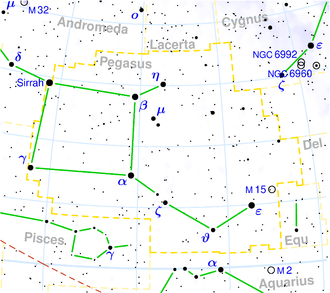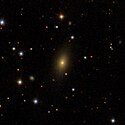IC 5293
| Galaxie IC 5293 | |
|---|---|
 | |
| SDSS-Aufnahme | |
| AladinLite | |
| Sternbild | Pegasus |
| Position Äquinoktium: J2000.0, Epoche: J2000.0 | |
| Rektaszension | 23h 14m 44,6s[1] |
| Deklination | +25° 08′ 26″ [1] |
| Erscheinungsbild | |
| Morphologischer Typ | S [2] |
| Helligkeit (visuell) | 14,6 mag [2] |
| Helligkeit (B-Band) | 15,4 mag [2] |
| Winkelausdehnung | 0,40′ × 0,2′ [2] |
| Positionswinkel | 175° [2] |
| Flächenhelligkeit | 11,7 mag/arcmin² [2] |
| Physikalische Daten | |
| Rotverschiebung | 0.026078 ±0.000077 [1] |
| Radialgeschwindigkeit | 7818 ±23 km/s [1] |
| Hubbledistanz vrad / H0 | (358 ± 25) · 106 Lj (109,7 ± 7,7) Mpc [1] |
| Geschichte | |
| Entdeckung | Stephane Javelle |
| Entdeckungsdatum | 22. November 1899 |
| Katalogbezeichnungen | |
| IC 5293 • PGC 70792 • CGCG 475-049 • 2MASX J23144460+2508262 • GALEXASC J231444.64+250825.9 • LEDA 70792 | |
IC 5293 ist eine Spiralgalaxie vom Hubble-Typ S im Sternbild Pegasus am Nordsternhimmel. Sie ist schätzungsweise 358 Millionen Lichtjahre von der Milchstraße entfernt und hat einen Durchmesser von etwa 40.000 Lj.
Im selben Himmelsareal befinden sich u. a. die Galaxien NGC 7548, IC 5295, IC 5296, IC 5297.
Das Objekt wurde am 22. November 1899 vom französischen Astronomen Stéphane Javelle entdeckt.[3]
Weblinks
Einzelnachweise
Auf dieser Seite verwendete Medien
Autor/Urheber: Sloan Digital Sky Survey, Lizenz: CC BY 4.0
The sky image is obtained by Sloan Digital Sky Survey, DR14 with SciServer.
Angle of view: 4' × 4' (0.3" per pixel), north is up.
Details on the image processing pipeline: https://www.sdss.org/dr14/imaging/jpg-images-on-skyserver/



